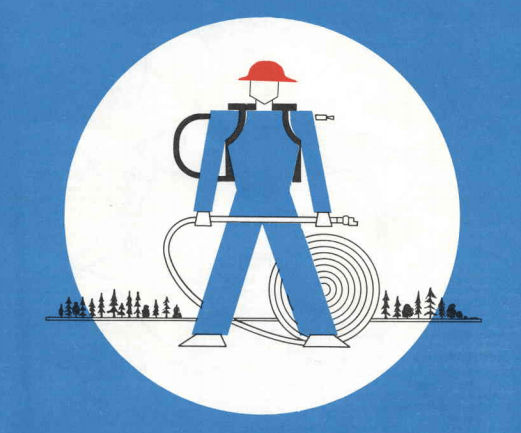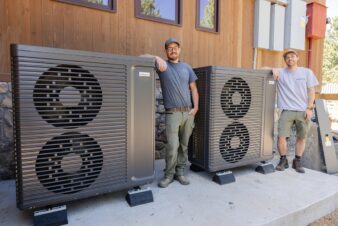In the October 1947 issue of Popular Mechanics there was an iconic drawing of a bomb dropping. However, this particular cover was war related, but of a “Water Bomb for Forest Fires.” The article talks about how warplanes were commissioned to fight on new front lines in the American West (Books.google.com).
My home in Colorado is one of many places in the U.S. on high alert for forest fires. Last year was a bad one for fires across the west and we have had a couple monster fires already this season. There is an abundance of dry fuel for fires to eat up because of another sweeping problem, the mountain pine beetle. Under normal circumstances, the mountain pine beetles prey on old dying pine trees. However, the warmer and dryer the average summers are, all trees start to look appetizing, not just the weak ones. The Rocky Mountain forests now have millions of acres of dead pine trees in the wake of the beetles, which makes for more explosive fires.
 Photo Credit: U.S. Forest Service—California Region: California Division of Forestry
Photo Credit: U.S. Forest Service—California Region: California Division of Forestry
The dead pine forests connect with the plumbing and heating industry in a few interesting ways. The beetle-killed trees can still be used for construction in some areas — the pine beetles kill the trees just under the bark, not throughout the whole trunk like a termite would. The wood could also be an enormous amount of fuel for high efficient wood or pellet stoves. Unfortunately, there are all sorts of hurdles to harvesting the dead wood from the stakeholders on the federal and private lands the trees rest on. In Colorado, for the most part, the wood is still sitting on the hills turning grey. Some areas around large communities have been cleared out, just to give fire fighters a defensible zone between the forest and homes, but the wood isn’t being put to much use otherwise.
One way to get rid of the trees is to just burn them where they are in a controlled fire. However, the risk is so high for the fire to get out of control that the local governments are hesitant to start anything. From an energy standpoint, this would not be the best way to use the obscenely large number of BTUs, but it is logistically simpler than moving it anywhere else. High efficiency wood burning stoves would be a much better place for all this wood, and would help to slow down or prevent forest fires by eliminating fuel in the forest.
Once a fire is started, delivering water by truck or by plane becomes the next challenge and it requires precise water management. In 1968, The U.S. Forest Service published a very cool guide to fighting forest fires, complete with hand drawn sketches. One unit of water, when properly applied can extinguish 300 units of burning fuel. Page 31 and 33 of the book have pressure and flow rate charts to help determine the amount of pump you will need for different scenarios. The next page has hand signals for working with a hose over a distance (Wildfiretoday.com). The signals seem like they would probably be useful in a noisy mechanical room.
In the Denver area, the U.S. Forest Service Jeffco Airtanker Base is a major filling station for aerial firefighting. “The sight has the capacity to mix 190,000 gallons of slurry (water, fire retardant, and additives) at a time, which is enough for seventy-four and a half 2,555 gallon drops. Jeffco supports a variety of aircraft types, including single engine airtankers, heavy airtankers, lead planes and helicopters” (USDA.gov).
One of the newest players on the aerial water delivery side of fighting fires is the Evergreen 747 Super Tanker. Evergreen claims that it will be able to carry eight times the capacity of other commonly used fire fighting planes. However, this $50 million dollar plane has yet to join the fight in Colorado fires this season for some reason. The current DC-10 aircrafts are still the common large tankers in the sky. In general, the fleets are composed of aging war cargo planes.
Helicopters are employed to fight fires, too. They are limited in capacity, but have the ability to grab more water in lakes and rivers near the fires. Modified Chinook helicopters are the larger of the rotary crafts. However, they are dwarfed in the overall capacity by the planes. In any craft, fighting fires with by air requires incredible piloting. Even the jets need to be as close to the tree line as possible to get the best use of every gallon. Sometimes they fly in just 200 feet above the tree line.
What is more effective than water for fighting fires? Wetter water. Regular H20 forms strong hydrogen bonds with itself. This resulting surface tension is why water beads on wax paper, raindrops are round, and water beetles can skate on top of a pond. Water molecules like bonding to other water molecules. By adding different additives to water (some are toxic, some are nontoxic) water can flow and disperse more effectively. Some claim that only 1 gallon of additive laden water can put out the same amount of fire as three gallons of normal water. Colors and dyes are also added in some cases to be able to show fire fighters where they have already canvased.
The smokejumpers, hotshots, pilots, fire fighters and support crews bring all these processes together and are nothing short of superheros. As I wrote this article, 19 firefighters were reported dead in a fire in Arizona. The danger these men and women run, fly, jump and drive into is unimaginable. It is nice to know modern plumbing and heating can also play a big part in keeping these fire teams safe.
Written by Max Rohr. Max is a LEED Green Associate and BPI Building Analyst. He is the current Chairman of the Radiant Professionals Alliance Education Committee and an outside salesman for Shamrock Sales Inc.
http://wildfiretoday.com/documents/WaterVsFire.pdf Page 37.
http://www.fs.usda.gov/detail/arp/about-forest/?cid=fsm91_058168




Join the conversation: